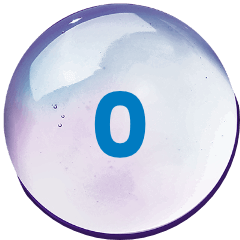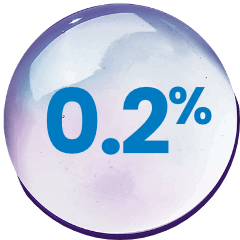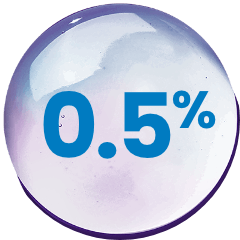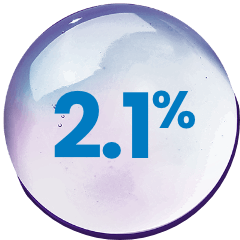UP NEXT
A tolerability profile you’ve been looking for1-3
In 2 pivotal clinical trials with >600
patients treated with MIEBO1:

No incidences of serious ocular adverse events (AEs)2,3
Most AEs were considered mild

Low discontinuation rate due to AEs2-4
Discontinuation rate for MIEBO was comparable to control (pooled: 0.2% vs 0.5%; GOBI: 0.3% vs 1.0%; MOJAVE: 0% vs 0%)

Low rate of burning or stinging2-4
The pooled incidence of instillation site pain, such as burning or stinging, was 0.5% (GOBI: 1.0%; MOJAVE: 0%)

One ocular AE with an incidence of ≥2%1-4
The most common ocular AE was blurred vision, which was mostly mild and transient. Blurred vision (pooled: 2.1%; GOBI: 3.0%; MOJAVE: 1.3%) and conjunctival redness (pooled: 0.8%; GOBI: 0%; MOJAVE: 1.3%) were reported in 1% to 3% of individuals
In the KALAHARI long-term extension study,
tolerability results were consistent with pivotal trials5
The primary safety endpoint was the incidence of ocular and non-ocular AEs
In a 1-year clinical study with
208 patients treated with MIEBO5:

No incidences of serious ocular AEs5
- 14% of patients had ≥1 ocular AE
- 24.5% had ≥1 non-ocular AE; most were mild (12.5%) or moderate (10.1%) in severity*

Low discontinuation rate due to AEs5
The most common ocular AEs were vitreous detachment (1.9% of patients, none considered treatment-related), allergic conjunctivitis (1.4%), blurred vision (1.4%), and increased lacrimation (1.4%)
*Only 1 non-ocular AE was considered by the investigators as related to study treatment.5
In the phase 4 study, outcomes reinforce the safety and tolerability profile established in phase 3 trials1-3,5,6
In a phase 4 clinical study with 99 patients treated with MIEBO6:

No incidences of serious ocular adverse events (AEs)6
- MIEBO was well tolerated with no reports of treatment-related AEs6
- One AE was reported: 1 patient experienced eye pain (in the right eye) that was moderate in severity and deemed as not serious and not related to treatment
- Tolerability was consistent with findings from the GOBI and MOJAVE pivotal trials and KALAHARI long-term safety extension study1-3,5,6
Study limitations include open-label design, lack of a control group, lack of assessment of clinical signs of DED (eg, corneal fluorescein staining score), and limited diversity of the study population. Data should be interpreted with the study design and these limitations in mind. No formal conclusions should be drawn.6
SD, standard deviation; VAS, Visual Analog Scale.
Watch this recommended video about MIEBO safety and tolerability

Key Perspectives on MIEBO: Excellent Tolerability
INDICATION
MIEBO® (perfluorohexyloctane ophthalmic solution) is indicated for the treatment of the signs and symptoms of dry eye disease.
IMPORTANT SAFETY INFORMATION
- MIEBO should not be administered while wearing contact lenses. Contact lenses should be removed before use and for at least 30 minutes after administration of MIEBO
- Instruct patients to instill one drop of MIEBO into each eye four times daily
- The safety and efficacy in pediatric patients below the age of 18 have not been established
- The most common ocular adverse reaction was blurred vision (1% to 3% of patients reported blurred vision and conjunctival redness)
You are encouraged to report negative side effects of prescription drugs to the FDA. Visit www.fda.gov/medwatch or call 1-800-FDA-1088.
Click here for full Prescribing Information for MIEBO.
References: 1. MIEBO. Prescribing Information. Bausch & Lomb, Inc. 2. Tauber J, Berdy GJ, Wirta DL, Krösser S, Vittitow JL; GOBI Study Group. NOV03 for dry eye disease associated with meibomian gland dysfunction: results of the randomized phase 3 GOBI study. Ophthalmology. 2023;130(5):516-524. doi:10.1016/j.ophtha.2022.12.021 3. Sheppard JD, Kurata F, Epitropoulos AT, Krösser S, Vittitow JL; MOJAVE Study Group. NOV03 for signs and symptoms of dry eye disease associated with meibomian gland dysfunction: the randomized phase 3 MOJAVE study. Am J Ophthalmol. 2023;252:265-274. doi:10.1016/j.ajo.2023.03.008 4. Data on file. Bausch & Lomb, Inc. 5. Protzko EE, Segal BA, Korenfeld MS, Krösser S, Vittitow JL. Long-term safety and efficacy of perfluorohexyloctane ophthalmic solution for the treatment of patients with dry eye disease: the KALAHARI study. Cornea. 2024;43(9):1100-1107. doi:10.1097/ICO.0000000000003418 6. Bacharach J, Kannarr SR, Verachtert A, et al. Early effects of perfluorohexyloctane ophthalmic solution on patient-reported outcomes in dry eye disease: a prospective, open-label, multicenter study. Ophthalmol Ther. 2025;14(4):693-704. doi:10.1007/
s40123-025-01097-z
INDICATION AND IMPORTANT
SAFETY INFORMATION
INDICATION
MIEBO® (perfluorohexyloctane ophthalmic solution) is indicated for the treatment of the signs and symptoms of dry eye disease.
IMPORTANT SAFETY INFORMATION
- MIEBO should not be administered while wearing contact lenses. Contact lenses should be removed before use and for at least 30 minutes after administration of MIEBO
- Instruct patients to instill one drop of MIEBO into each eye four times daily
- The safety and efficacy in pediatric patients below the age of 18 have not been established
- The most common ocular adverse reaction was blurred vision (1% to 3% of patients reported blurred vision and conjunctival redness)
You are encouraged to report negative side effects of prescription drugs to the FDA. Visit www.fda.gov/medwatch or call 1-800-FDA-1088.
Click here for full Prescribing Information for MIEBO.
FAQs


